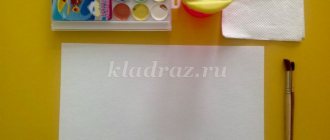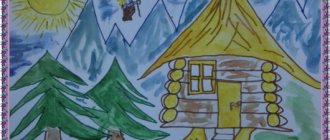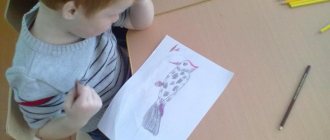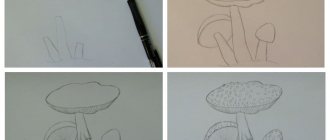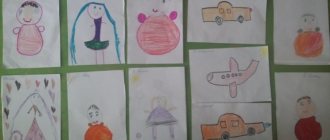Irina Krasnozhonova
Summary of a lesson in visual arts in the preparatory group. Drawing “My favorite toy”
Lesson summary on visual arts in the preparatory group
.
Topic: “My favorite toy
"
.
Goal: 1. Identify the level of development of artistic abilities for visual activity
, the ability to accept and independently implement a creative task. Develop imagination, attention, accuracy.
2. Improve your gouache painting
, paint over the drawing, observe the proportions of the drawing correctly.
3. To cultivate aesthetic taste and interest in artistic creativity.
Materials and equipment: gouache, brushes, jars of water. Napkins, palette, sheets of paper.
bear
Everyone, young and old, loves a teddy bear. The baby falls asleep with it, the girl holds it touchingly in her hands, hoping for a miracle, it sits on the grandmother’s shelf and waits for her grandchildren. And they are all so different and cute. Let's look at how to draw a toy with a pencil step by step. Take a white sheet of paper and visually divide it horizontally into two parts. The middle is the approximate line of connection between the head and the body. On the bottom half of the sheet, draw a plump oval with a pencil - this is the body of the toy. Draw a round head to the upper part of the body, slightly overlapping it. Draw a vertical line through the sketch, dividing the toy into two symmetrical parts. The bear cub's paws are slightly elongated. Sketch out the upper and lower limbs, covering part of the torso at the junction. The toy's paws should be spread apart as if he wants to hug you. Clumsiness in the drawing is encouraged, it will give the toy realism. Focusing on the midline of the head, draw a round muzzle. Next, draw circles on the top of the head - these are the ears of the clubfoot. And also for the lower limbs, draw the feet in the form of two ovals.
Variants of compositions within the theme “My favorite fairy tale”
Drawing on the theme “My Favorite Fairy Tale” is traditionally offered to students in the senior group in the first half of the year (November). The task of preschoolers is to convey an episode, to draw the characters of a fairy tale in a certain setting. Note that shortly before this lesson, children are invited to draw fairy-tale houses. It is easier, since the guys do not depict the plot, but individual objects - the homes of fairy-tale characters.
Preschoolers can draw any fairy tale of their choice. However, it is advisable to first invite them to depict their favorite episode from a specific fairy tale (such drawing can be timed to coincide with the corresponding lesson on speech development). At the same time, the teacher highlights key episodes that may interest children. For example, if we consider the fairy tale by D. N. Mamin-Sibiryak “The Gray Neck,” then we can depict how the ducks fly away to the south, and the Gray Neck remains swimming in the lake. Another option is that a duck swims in a small hole, and a fox crawls up to it in the snow.
In addition to this fairy tale, we can recommend holding drawing classes in the senior group on any of the following topics:
- Plot drawing based on fairy tales that children were familiar with in early preschool age (“Turnip”, “Kolobok”, “Ryaba Hen”, “Geese-Swans”, “Masha and the Bear”, “Three Bears”).
- Depiction of episodes from fairy tales that preschoolers are introduced to directly in the senior group during classes on speech development or during additional reading in their free time (“Spikelet”, “Winged, Hairy and Oily”, “The Fox and the Jug”, “Goby - Tar Barrel”) ", "At the behest of the pike", "The Tale of Tsar Saltan" by A. S. Pushkin, drawing based on the prologue to the poem "Ruslan and Lyudmila" - "There is a green oak at the Lukomorye...", "Little Red Riding Hood" by Ch. Perrault, "Bubble, straw and bast shoe").
- Many stories can be drawn from the fairy tales of V. Suteev (“Under the Mushroom”, “Rooster and Paints”, “Apple”, “Sack of Apples”, “Different Wheels”).
As for collective works, in addition to the composition based on the work “Gray Neck”, you can offer to depict an episode from the fairy tale “Geese and Swans”: the teacher prepares the main background, and the children draw: some - Baba Yaga’s hut, others - a forest, others - flying swans. Another option is to create an illustration for V. Suteev’s fairy tale “Under the Mushroom” (children work in subgroups of 5-6 people). The teacher schematically depicts a large mushroom, and the children color it and draw characters.
Drawing details
We have a sketch of the bear ready, let's move on to the details and the final stage. Find a symmetrical arrangement of the eyes and draw them. Create a nose on the muzzle. Don't forget about the toes and palms of the upper limbs. At the end of the work, erase unnecessary features and lines with an eraser, correct the face by adding a smile and eyebrows. And so that our little bear doesn’t get bored, let’s look at how to draw toys around him.
Table: notes from fairy-tale-themed drawing classes
| Author and theme of GCD | Progress of the lesson |
| Golynova I. “Fairy tales walk around the world. Drawing fairy-tale characters" | Educational objectives: learn to convey an episode from a favorite fairy tale in a drawing, create a composition according to plan. Developmental tasks: improve the ability to draw with wax crayons, develop imagination, creative imagination. Educational objectives: to cultivate interest in fairy tales. Integration of educational areas: “Artistic creativity”, “Cognition”, “Communication”, “Socialization”, “Health”. Demonstration material: Pinocchio toy. Handouts: sheets of white paper according to the number of children, wax crayons. Progress of the lesson: Preschoolers stand in a circle, the teacher invites them to go to a fairy tale, pronounces magic words. A toy Pinocchio appears in front of the children (the children guess that he came from the fairy tale “The Golden Key”). The character conducts a mini-quiz with children on the topic “Fairy Tales”. The first task is to guess the fairy-tale hero (the teacher shows the corresponding slides):
The second task is the didactic game “What’s extra?” (the picture shows several characters from the same fairy tale, but one of them is redundant).
Next, a physical school is held, after which the children are invited to draw their favorite fairy-tale characters in an appropriate setting. The teacher reports that upon completion of the work, she will place all the drawings in a magazine called “Our Favorite Fairy-Tale Characters.” The teacher reminds the correct techniques for drawing with wax crayons: how to hold them, how to apply strokes. After performing finger gymnastics, the guys get to work. All drawings are placed in a magazine. Pinocchio is happy. Exit from the fairy tale - the children close their eyes, the teacher says the magic words, and they return to the group. Quote from: https://www.maam.ru/detskijsad/konspekt-integrirovanogo-zanjatija-v-starshei-grupe-na-temu-skazki-guljayut-po-svetu-risovanie-skazochnyh-personazhei.html |
| Mokretsova A. “My favorite fairy tale “Kolobok” | The lesson begins with a riddle about a kolobok:
An illustration depicting the hero is hung on the board. Children remember what animals he met in the fairy tale. The distinctive features of a hare, wolf, bear, and fox are discussed. The teacher conducts a word game “Say a word”:
Physical school is being held.
The teacher invites the children to turn into illustrators and draw pictures for the fairy tale “Kolobok”. Preschoolers begin to draw, and at this time the teacher reads to them the fairy tale “Kolobok”. Quote from: https://www.maam.ru/detskijsad/konspekt-nod-po-risovaniyu-moja-lyubimaja-skazka-kolobok.html |
| Gorchakova O. “Cockerel” (drawing based on the fairy tale “Rooster and Paints” by V. G. Suteev) | At the beginning of the lesson, the teacher invites the children to remember which fairy tales by V. Suteev they know. Then she reads them a new fairy tale, “The Rooster and the Paints,” while showing them the illustrations. A physical education session is held to the musical composition “Waltz of the Cockerels” by I. Stribogg. Then the teacher invites the children to depict the main character of V. Suteev’s fairy tale in an unusual way - you need to trace your palm with a simple pencil - this will be the head of a cockerel along with a comb. And the hand is his neck. The thumb resembles a beak and should be painted yellow. The cockerel's mouth will be open as he sings his song. To complete the look, you need to add a beard. The tail is painted with the same colors as in the fairy tale. Independent activity of preschoolers. Quote from: https://www.maam.ru/detskijsad/kompleksnoe-zanjatie-v-starshei-raznovozrastnoi-grupe-po-skazke-vg-suteva.html |
| Gordeeva T.G. “At Lukomorye” (drawing with a stencil) | The teacher invites the children to go to the fairy-tale country of Lukomorye, which was invented by the famous Russian poet Alexander Sergeevich Pushkin (a portrait is shown). Children do eye exercises:
A mini-quiz is held: the teacher reads an excerpt from Pushkin’s fairy tale, and the children must guess it.
Physical school is being held. The teacher talks with the children about which fairy-tale characters live in Lukomorye, and looks at the illustrations for the poem. The teacher invites the children to build a fairy-tale composition on a flannelgraph, while simultaneously discussing with the children the structure of an oak tree, a cat, etc. Finger gymnastics is carried out:
Independent activity of preschoolers - they draw a cat using a stencil, complementing the image with the necessary details (oak tree, sun, clouds, hut on chicken legs, etc.). Children draw the crown of an oak tree in an unusual way - with crumpled paper. Review of finished works. The teacher analyzes 1–2 drawings in detail. Quote from: https://www.maam.ru/detskijsad/konspekt-nod-po-risovaniyu-v-starshei-grupe-tema-u-lukomorja.html |
Pyramid
On the left side of the teddy bear, you can draw a children's wooden pyramid. Let's remember what it is. This cone-shaped toy consists of multi-colored rings that are placed on the axle in order from largest to smallest ring. The top of the pyramid is covered with a top. Start drawing by drawing a vertical axis, noting the height of the toy. Then draw the base of the largest ring perpendicular to the axis. Connect the edges of the base to the top - you should get a tall triangle with identical bottom corners. Next, at an equal distance from each other, mark the location of the rings on the axis with thin strokes. After that, draw the details. The elements will become smaller towards the top; decorate the top of the cone with a candle-shaped nozzle. Here we looked at how to draw a toy step by step.
To the right of the bear we will draw a ball. It's very easy to draw. The base of the toy is a circle. You can use a compass or circle something round. Divide it visually into four parts and draw a small oval in the upper right corner, indicating the middle of the ball. Next, from the small oval, we draw the stripes closest to us, those far away, and parts of those stripes that go beyond the ball from the field of view. Then, using pencils, we paint over the pattern on the ball one by one.
From this article we learned how to draw toys for children. The same ones that were so loved in childhood. After all, love for one’s neighbor and animals is born in hugs with a teddy bear, and motor skills and knowledge of the world are born in assembling a pyramid. The ball implies the physical development of the child.
Target:
Features of drawing on the topic “Fairy Tale” in the senior group of preschool educational institutions
Drawings on a fairy-tale theme in the older group are, as a rule, plot compositions. Children aged 5–6 years already know how to correctly position an image on paper, convey the proportions of objects, and understand that some objects can partially block others. Preschoolers have developed aesthetic taste to a certain extent, and have primary skills in drawing such complex objects as animals and humans.
Drawing based on a fairy-tale plot gives boundless scope to children's imagination.
The fairy tale as a genre of literature has its own unique characteristics: it organically combines real ideas about the world (folk life, nature) and incredible fantastic images. Accordingly, in children's drawings on a fairy-tale theme we can see a combination of familiar and magical objects and objects. Works on this topic are distinguished by their boldness and richness of image.
To turn the image into a fairy tale, children change its real color (for example, a magic bird or a horse). Sometimes color combinations are used to add mystery to the image. For example, the sky may be orange with red stripes - such a background conveys the alarming atmosphere of the picture, which depicts how a sorcerer carries a hero over the earth.
Compositions on a fairy-tale theme often convey certain actions of the characters. Dynamics can be achieved by changing the position of an object in space or its individual parts (for example, the direction of the legs and tail of a horse). A person can stand with his hands down, but if he is passing an object to another character, then his hand must be raised and extended.
Familiarity with reproductions of paintings by talented artists is of great importance for teaching older preschoolers how to draw on fairy-tale subjects. These are the famous works of Vasnetsov “Ivan the Prince on the Gray Wolf” and “Alyonushka”, Roerich “Overseas Guests”, Vrubel “The Swan Princess”. Children should always have book illustrations before their eyes. In the process of perceiving a picture, observation and imagination develop - qualities necessary for the formation of creative imagination.
When offering children certain fairy-tale themes, the teacher must discuss with them the key features of the images:
- When depicting the Ryaba hen, such a characteristic feature will be its beautiful plumage, the crest (after all, this is not an ordinary chicken). The expressiveness of this image can also be emphasized with an unusual color scheme.
- In the composition on the theme “Geese-Swans”, the location and time of day, the distinctive features of ancient peasant clothing (bast shoes, sundress, shirt) and objects (Russian hut, stove) are important.
- When drawing Ivan Tsarevich, children should also pay attention to his clothes - an old caftan, a hat with a lapel, patterned boots.
- Depicting a ship sailing on the sea (“The Tale of Tsar Saltan”), the guys convey its characteristic shape and structure; in this composition, the image of the sky is also important.
- If children draw the Snow Maiden from the Russian folk tale of the same name, then their task is to make this image expressive due to its harmony and selection of cool colors.
When depicting the Snow Maiden, children select cool tones of paint.
As experience shows, when drawing on fairy-tale themes, some children pay the main attention to the color scheme of the composition, others to the rendering of characteristic magical objects, and still others to the compositional solution (thoughtful background and arrangement of objects). In addition, children use such a technique as strengthening individual features that are present in the real prototype. For example, Baba Yaga is an ordinary old woman, only with a huge crooked nose and warts.
As for plot drawing, ideally it should be preceded by a subject image. For example, children draw dogs of different breeds, sculpt a dog with a border guard, and only after that they are asked to draw an illustration for the fairy tale “Ivan Tsarevich and the Gray Wolf.”
Drawing on the theme “My favorite fairy tale” is a creative work, and therefore does not require a teacher’s sample. It is replaced by illustrations for fairy tales. You can also provide children with diagrams of a step-by-step depiction of some objects, for example, the Gray Neck duck from the fairy tale by D. Mamin-Sibiryak.
The image of a duck is made up of figures that are easy to depict.
When drawing step by step, it is important to give a general image with as few details as possible, leaving room for children's imagination.
Gray Neck is easy to draw based on diagrams.
In the senior preschool level, much attention is paid to the analysis of finished works. After finishing drawing, the teacher invites the children to talk about their drawing, about the nature of the characters depicted, and to evaluate the work of their comrades. Moreover, it is necessary to obtain detailed answers from children, and not simple assessments of “beautiful” or “ugly.”
Materials used and base
For drawing on fairy-tale plots, the teacher offers children a standard basis (a sheet of A4 paper). When painting with paints, the paper is usually tinted. In some cases, children themselves depict the background (for example, when coloring the sky gives the drawing additional expressiveness).
In the drawing based on the fairy tale “Little Red Riding Hood,” the child independently filled the entire background with color.
Since this is a creative work, preschoolers should not be limited in the choice of materials - compositions on the theme of fairy tales are equally effective when using watercolors, gouache, and colored pencils. Wax crayons and felt-tip pens are also suitable for such work. In some cases, a combination of materials is appropriate (for example, using a felt-tip pen to outline the outline of objects).
To make the drawing more accurate, it is advisable to first draw key objects and objects with small details with a simple pencil.
Using a pencil and felt-tip pen makes the composition more original
Drawing techniques and techniques that should be used when drawing fairy-tale scenes in the senior group
When drawing on fairy-tale themes, preschoolers in the older group improve their drawing techniques with paints and colored pencils. Drawing the outline with a simple pencil should be light - rough lines can ruin the finished composition. Working with colored pencils or wax crayons, children convey a variety of shades of color. This is achieved by adjusting the pressure force.
Note that chalk makes it possible to draw a wide textured line. You need to keep it close to the base without squeezing too hard. You need to paint over the image evenly, leaving no gaps. A child in the older group must regulate the speed of his hand: the middle of the outline is painted with quick movements, long strokes, and the edges with short and slow strokes.
Drawing with wax crayons combines two advantages: the crayons are bright, like paint, but do not spread
The use of gouache gives compositions bright and saturated colors, but for the development of visual skills, preference should be given to watercolor paints. They allow children to experiment with the transparency of color (by changing the ratio of water to paint). When working with a brush, the children practice drawing techniques with the entire bristle and tip.
The use of additional types of visual activities and an individual approach
A fairy-tale theme encourages the inclusion of additional elements (appliqué or sculpting) into the composition. So, a painted turnip decorated with green leaves made of colored paper will look very original. A plasticine bug can complement the image.
Drawing with elements of appliqué and sculpting is a good solution for conveying an image
The feathers of a fabulous Firebird or the mane of a magical horse can be decorated with shiny sequins and even golden threads. For a fairy tale cockerel, for example, the hero of V. Suteev’s fairy tale “The Rooster and the Paints,” you can make a voluminous tail from multi-colored strips of colored paper (only the ends are glued on).
For drawings on fairy-tale themes, gouache with glitter is perfect. For example, in this way you can interestingly depict the Golden Fish from the fairy tale by A.S. Pushkin.
The image of a goldfish decorated with sequins looks very fabulous
Similar image techniques can be offered to all preschoolers, or they can be used as part of an individual approach, offering diversification of the composition to children who quickly and efficiently cope with the main task. Drawing based on some fairy tales can be designed as a collective composition using different types of visual activities. For example, D. Mamin-Sibiryak’s fairy tale “The Gray Neck” is suitable for this purpose. On a sheet of whatman paper, several children depict a background - a forest, a sky. Others draw a lake, its shores covered with grass or snow (depending on the chosen episode). The rest of the guys sculpt fairy tale characters (fox, duck, hares, hunter, etc.).
Examples of finished works by senior group students on the topic “My Favorite Fairy Tale”
Simple fairy tales for little ones provide rich material for depiction. Children create bright compositions based on them, attracting with the vividness of their images and multi-colored colors. So, the interpretations on the theme “Kolobok” are interesting. The foreground in them is either the gingerbread man himself (the works “The Cheerful Gingerbread Man”, “The Gingerbread Man on a Stump”), or the sly fox (“The Fox is Getting Ready to Eat the Gingerbread Man”, “The Gingerbread Man Met the Fox”, “The Gingerbread Man and the Fox”). The red-haired beauty turned out especially impressive in the drawing “Kolobok and the Fox.”
Photo gallery: illustrations for the Russian folk tale “Kolobok”
Watercolor drawing “Kolobok sat on the fox’s nose” Watercolor drawing “Kolobok and the fox”
Watercolor drawing “Cheerful bun”
Watercolor drawing “Kolobok met a fox”
Pencil drawing “Kolobok on a stump”
Photo gallery: illustrations for the fairy tale “Turnip”
The images in the drawing “Grow, turnip, big, big” are carefully drawn
Pencil drawing “A turnip has grown”
Expressive images of fairy tale characters are presented in the composition “Pulling, pulling, not pulling”
Drawing in an unconventional way using foam rubber “Beauty Turnip”
Photo gallery: illustrations for fairy tales by V. Suteev
Drawing with appliqué elements looks more original
Watercolor painting “The fungus will grow soon”
Palm drawing “Under the mushroom”
The drawing of a cockerel can also be made using the palm painting technique
Photo gallery: illustrations for the fairy tale “The Gray Neck”
Watercolor painting “Gray Neck” conveys the autumn mood
The picturesque landscape is presented in the composition “Gray Neck on the Lake”
The work “Beware, Gray Neck” turned out to be dynamic
